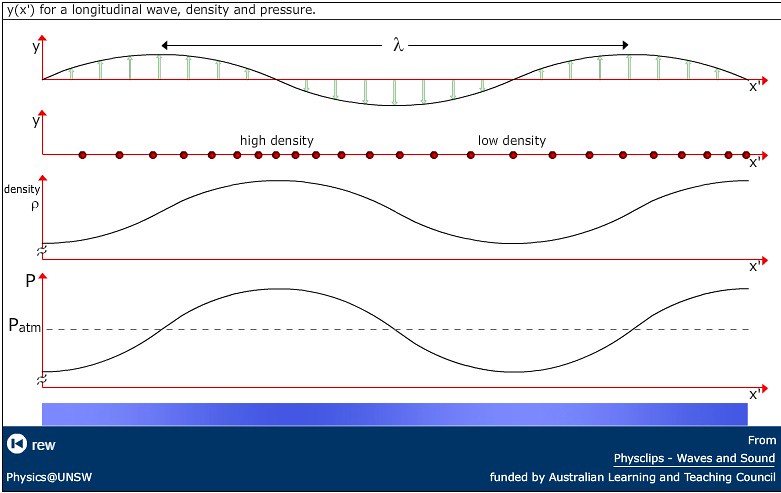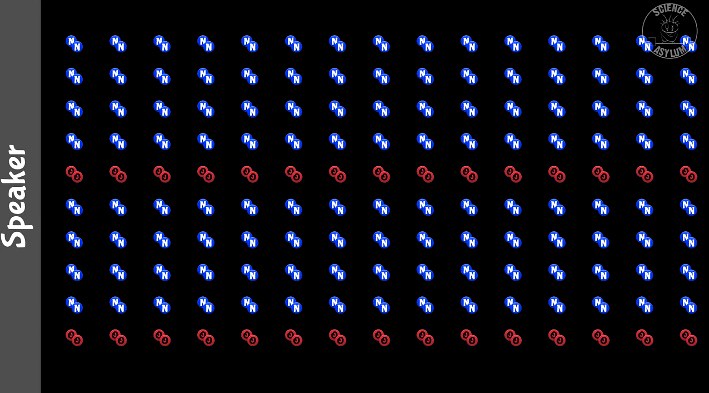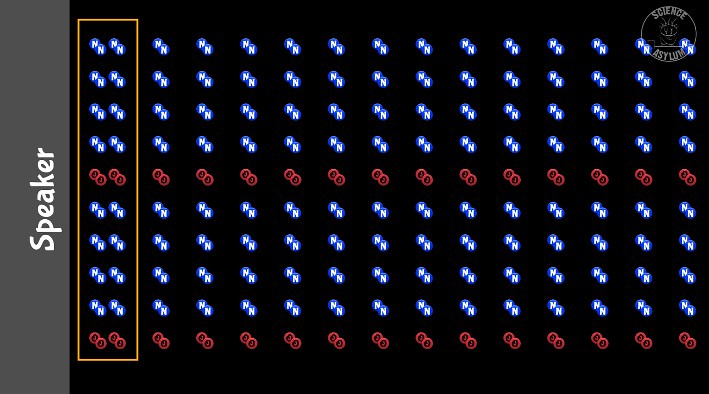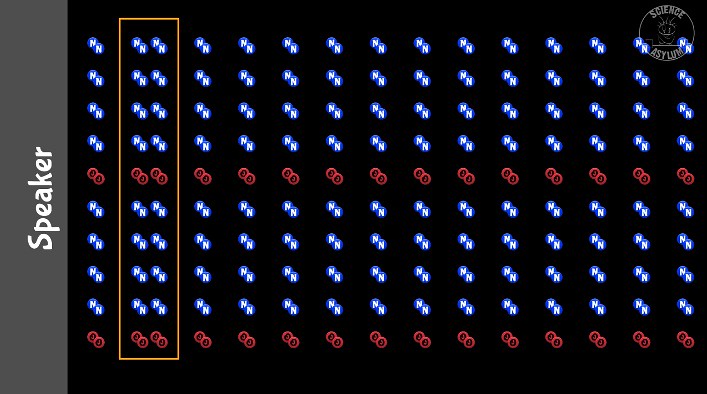Science Communication Made Simple
The actor Alan Alda -- better known for his role of 'hawkeye pierce' (a doctor) in the military show "M.A.S.H.". He went onto to have a super successful acting career. While narrating a show about science, he started to think about incorporating 'improv' into science communication. Out of that original thought process emerged the Alan Alda School for Science Communication.
There are classes and conferences offered on campus along with conference tours (around the U.S.) throughout the year. In addition, there are challenges that emerge to inspire creativity and simplicity in explaining difficult concepts. One such concept is 'Sound'. The challenge is called "The Flame Challenge." A variety of topics are chosen. Here is the video for "The Flame Challenge: What Is Sound" below:
Physics Of Sound
The video above describing sound as the movement of pressure waves through air is consistent with the 'Wikipedia' page for "Sound":
In physics, sound is a vibration that propagates as a typically audible mechanical wave of pressure and displacement, through a transmission medium such as air or water. In physiology and psychology, sound is the reception of such waves and their perception by the brain.[1] Humans can hear sound waves with frequencies between about 20 Hz and 20 kHz. Other animals have different hearing ranges.
The physics of sound can be represented as a wave on a string. The University of Sydney, Australia -- School of Physics hosts a webpage which is filled with examples. One example is the representation shown below of a wave on a string:
In the illustration above, there are 4 graphical representations of the transmission of sound. Starting from the top, the simplest representation of sound is a 'sound wave' represented by wave motion induced on a rope. Starting from the left and working our way to the right, a single complete 'wavelength' is represented by the greek letter 'lambda'. Waves are the most common representation of sound. Usually, waves are represented in a pattern of waves shown on an electrical oscilloscope -- which measures wavelength and frequency.
The second illustration down is of 'atoms' or 'molecules' on the x-axis. At first glance, the spacing is not repetitive and can be misunderstood. In order to make sense of the spacing of the 'molecules' on the x-axis, we need to look at the graph #3 just underneath #2. In the 3rd graph, the wave-like pattern is a graph of 'density' of sound distributed over the x-axis to form a 'sound wave'. At the crest (the highest point) of the wave, the spacing is the smallest and compressed to represent a region of 'high density', whereas the 'trough' or low point is represented by larger spaces between 'molecules' on the x-axis. This representation is more difficult to understand to most people at first sight.
Although, the common definition in physics of 'sound' is the transmission or propagation of sound through a 'medium' such as air or water. In order to carry the sound wave through the air, the molecules of air will have to move like those in the 2nd graph above. In the video above, the author did a wonderful job of representing the transmission of sound through air. Lets take a look at a few of his slides to drive the point home.
In the first slide below, there are vertical columns of air molecules all lined up:
The second illustration down is of 'atoms' or 'molecules' on the x-axis. At first glance, the spacing is not repetitive and can be misunderstood. In order to make sense of the spacing of the 'molecules' on the x-axis, we need to look at the graph #3 just underneath #2. In the 3rd graph, the wave-like pattern is a graph of 'density' of sound distributed over the x-axis to form a 'sound wave'. At the crest (the highest point) of the wave, the spacing is the smallest and compressed to represent a region of 'high density', whereas the 'trough' or low point is represented by larger spaces between 'molecules' on the x-axis. This representation is more difficult to understand to most people at first sight.
Although, the common definition in physics of 'sound' is the transmission or propagation of sound through a 'medium' such as air or water. In order to carry the sound wave through the air, the molecules of air will have to move like those in the 2nd graph above. In the video above, the author did a wonderful job of representing the transmission of sound through air. Lets take a look at a few of his slides to drive the point home.
In the first slide below, there are vertical columns of air molecules all lined up:
Notice on the left side of the illustration (along the wall) the word "speaker" is written. This is to illustrate the point from which the sound wave will be generated -- similar to the speaker in your electronic devices. At this point, there is no sound wave emerging from the speaker.
The slide below shows the emergence of a sound wave starting from the speaker:
The brown box (or dark orange) shows the emergence of a sound wave by the compression (smaller spacing of air molecules) starting at the left hand side. As the wave propagates through a medium, the spacing will move from left to right as shown in the next three slides below:
and without the box, the wave continues to move as compressed molecules as shown below:
And ...
By now, the wave has traveled just under half-way across the medium in the illustration above.
The take home message is that sound can move through a medium such as air as a series of 'changes in pressure' as represented in the 4th graph in the first illustration above. Now that you are educated in the transmission of sound, you can tackle an age old question regarding a tree in the forest.
Tree Falling In The Forest
Whenever science students encounter the section on sound in physics, the inevitable philosophical experiment is brought up. The philosophical experiment is a test 'of observations and the knowledge of reality.' According to the 'Wikipedia' page for the philosophical experiment, the question is stated as follows:
"If a tree falls in a forest and no one is around to hear it, does it make a sound?"
The earliest mention of the problem was from the philosopher George Berkeley in the excerpt below:
Philosopher George Berkeley, in his work, A Treatise Concerning the Principles of Human Knowledge (1710), proposes, "But, say you, surely there is nothing easier than for me to imagine trees, for instance, in a park [...] and nobody by to perceive them.[1] [...] The objects of sense exist only when they are perceived; the trees therefore are in the garden [...] no longer than while there is somebody by to perceive them."[2] (It is worth noting that the quote from section 45 is arguably a statement of an objection to Berkeley's view, and not a proclamation of it.) Nevertheless, Berkeley never actually wrote about the question.[3]
The question is simple. Science students love to argue about this. Of course, if you are not present, then the question really becomes simple if you stick with the rules of sound illustrated in the graphs above. The statements can be made regarding the tree falling:
1) As the tree falls the sound that is generated is generated as compression of molecules in the medium (air) between the tree and the surrounding area.
2) Noise is perceived by the human ear or a sensor (such as a microphone) which has a moving part that reacts to the compressed molecules transmitting the sound wave propagating through the air.
Returning to the 'Wikipedia' page for the philosophical experiment, an excerpt from the magazine 'Scientific American' elegantly states a solution to the problem shown below:
The magazine Scientific American corroborated the technical aspect of this question, while leaving out the philosophic side, a year later when they asked the question slightly reworded, "If a tree were to fall on an uninhabited island, would there be any sound?" And gave a more technical answer, "Sound is vibration, transmitted to our senses through the mechanism of the ear, and recognized as sound only at our nerve centers. The falling of the tree or any other disturbance will produce vibration of the air. If there be no ears to hear, there will be no sound."[5]
Therefore, no sensor present (human ear, microphone, sensor) then the tree did not make a 'sound' as we perceive sound. The pressure wave was generated but no sensor was present to transform that pressure wave into an audible sound!!!
Conclusion...
In the paragraphs above, we learned that sound is generated as a change in pressure or density in the air or other medium (water, etc.). Further, that if there is no sensor or human ear present, then no sound can be heard. A more difficult problem is when you are standing in a crowd and cannot hear a speaker who is located far ahead (far away) from you. Why can't you hear them?
The reason is that the amplification of the noise is not strong enough to transmit a wave to where you are standing. That is why there are speakers lining up along a large crowd. Noise will die out as the compresseion wave loses energy! When the volume is turned up on a sound system, the noise is amplified further to transmit the wave further.
Alan Alda is delivering a great service for the community along with the Kavli institute to educate the public about science. Additionally, getting scientists on board with better (and simpler) communication is critical to the transmission of ideas and important concepts that affect science and society. With videos like the one above produced by enthusiastic scientist, we are closer to educating the public about the importance of science and science communication.
Until next time, Have a great day!!!






No comments:
Post a Comment